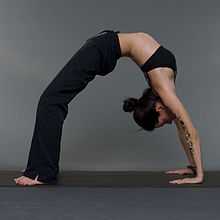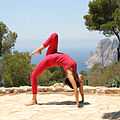Chakrasana

Chakrasana (Sanskrit: चक्रासन IAST: Chakrāsana, Wheel Pose), also called Urdva Dhanurasana (Sanskrit: ऊर्ध्वधनुरासन; IAST: Ūrdhvadhanurāsana, Upward-Facing Bow Pose) is an asana. It is a backbend and part of the finishing sequence in the Primary Series of Ashtanga Yoga.
Etymology
The name comes from the Sanskrit words Chakra (चक्र, Cakra) meaning "wheel",[1] and Asana (आसन, Āsana) meaning "posture" or "seat".[2][3]
Description
In the general form of the asana, the practitioner has hands and feet on the floor, and the abdomen arches up toward the sky. Wheel Pose may be entered from a supine position or through a less rigorous supine backbend, such as Setu Bandha Sarvangasana (Bridge Pose). Some advanced practitioners can move into Wheel Pose by "dropping back" from Tadasana (Mountain Pose), or by standing with the back to a wall, reaching arms overhead and walking hands down the wall toward the floor. Advanced practitioners may also follow wheel with any of its variations (listed below), or with other backbends, such as Dwi Pada Viparita Dandasana, or by pushing back up to stand in Tadasana.
Benefits
General Benefits: Strengthens back muscles, tones adrenals, helps kidneys, front part of the body is being stretch entirely, which is good for people who are introverts as the openness in the heart may work on their heart chakra. Due to the stretch at the upper part of the abdomen muscles, it gives some pressure on the internal organs of the abdomen and therefore, increasing their efficiency. The muscles on the front part of the thighs are stretch and the calves are strengthening while doing and holding the pose. This will also help to strengthen the leg muscles. This pose is extremely beneficial for those who sit long hours in front of the desk or computer as they usually hunch over the desk all day long. The backward bend in the pose will relieves tension or stress from the body and help in decreasing the ailments arising out of it. This pose will also help in toning and strengthening the entire back muscles.
Benefits for Women: Tones pelvic region
Therapeutic Applications: Stress. Anxiety, Asthma
Variations
- Eka Pada (One-Legged) Chakrasana//Urdhva Dhanurasana
- one leg is lefted straight up into the air.[4]
- Eka Hasta (One-Handed) Chakrasana//Urdhva Dhanurasana
- one arm is raised off the ground and placed on the thigh or knee.
Gallery
-

A variation of Eka Pada Chakrasana
See also
References
- ↑ "Chakrasana - AshtangaYoga.info". Retrieved 2011-04-11.
- ↑ Sinha, S.C. (1 June 1996). Dictionary of Philosophy. Anmol Publications PVT. LTD. p. 18. ISBN 978-81-7041-293-9. Retrieved 9 April 2011.
- ↑ Kaul, H. Kumar (1 July 1993). Yoga and drug addiction. B.R. Pub. Corp. p. 92. ISBN 978-81-7018-742-4. Retrieved 9 April 2011.
- ↑ "Eka Pada Chakrasana". Jaisiyaram. Retrieved 21 March 2013.
Further reading
- Iyengar, B. K. S. (1 October 2005). Illustrated Light On Yoga. HarperCollins. ISBN 978-81-7223-606-9. Retrieved 9 April 2011.
- Saraswati, Swami Satyananda (1 August 2003). Asana Pranayama Mudra Bandha. Nesma Books India. ISBN 978-81-86336-14-4. Retrieved 9 April 2011.
- Saraswati, Swami Satyananda (January 2004). A Systematic Course in the Ancient Tantric Techniques of Yoga and Kriya. Nesma Books India. ISBN 978-81-85787-08-4. Retrieved 9 April 2011.
External links
| ||||||||||||||||||||||||||||||||||||||||||||||||||||||||||||||||||||||||